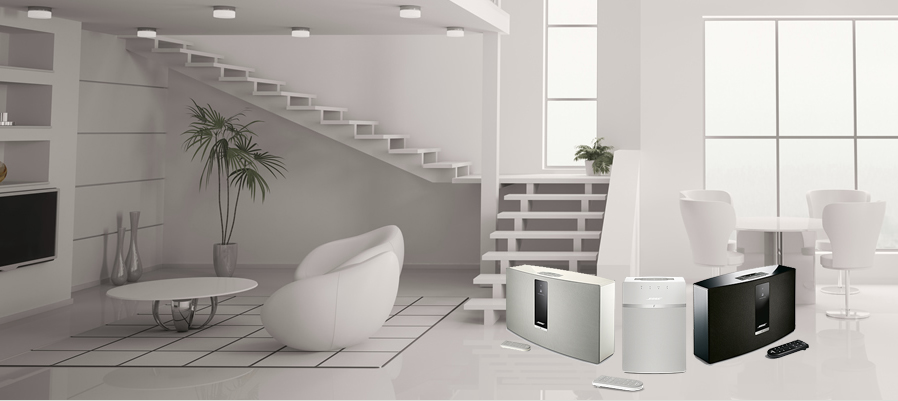
HOME AUDIO
With the touch of a single button, you can be listening to your favorite playlist for the big party, family gathering, or for a little pleasent background music. The key to a system's ease of use is the user interface. Many systems can be cumbersome and difficult to operate.
Multi Room Music: Which Strategy Fits Your Home?
Multi-room music (sometimes called whole house or multi-zone music) is available in three configurations: single zone, multi-zone, and so-called “second” (or even third) zone. Recently, wireless multi-room solutions have also become available.
Single zone. A single-zone system allows one source (CD, streaming, FM, etc.), to be selected and then played in any room having speakers connected to the system. A volume control—either wall-mounted in the room or at the amplifier—is assigned to each speaker pair to control the sound level in that room. With this approach, ever room gets the same music.
Single zone systems make sense for small apartments, homes occupied by only one person (or two with the same taste in music), or homes with open floor plans (where isolating the sound from room to room isn’t possible). Keep in mind that most consumer-grade stereo amplifiers and receivers can drive no more than two pairs of speakers at the same time. If three or more pairs of speakers are needed, a special distribution amplifier is typically used to can handle the additional load, along with special “impedance-matching” volume controls.
Multi-zone. With this system type, a keypad located in each room is used to control a special multi-zone pre-amp/amplifier. This allows the user to select a music choice for each room from whatever sources are available (FM, CD, streamed audio), and also to adjust the volume, change stations or songs, and switch between sources. Multi-zone preamp/amps are available for 4, 6, or 8 rooms, and can be doubled up for more zones if needed. A sub-zone may also be created—for example, by adding master bath speakers to the master bedroom zone. Some multi-zone systems allow a single keypad to control two or more zones, and can even display the name of the song being played. This feature—called meta-data display—is especially useful when navigating sources that provide the name of the song, as with streamed audio content.
Second Zone. Some surround receivers provide an additional choice. Called second zone capability, this feature allows the reassignment of unused “surround” channels (a 7.1 receiver which is set up as a 5.1 system, for example) to send powered stereo content to speakers in a second (or even third) location— without the cost and complexity of adding additional amplification and cross-connecting the sources.
Wireless music. In conventional multi-room music, all three of the above approaches require speaker wiring to each room where music is desired. Multi-zone systems also required control wiring from the multi-zone preamp to a keypad in each zone.
Wireless multi-zone systems have recently become available from several manufacturers—which simplify installation when wiring is not already in place. They consist of a wireless transmitter/ preamp unit at the source (or “head”) end, and a wireless amplifier plus bookshelf-style speakers (or a unit that combines both) at the listening location. It is important to understand that while these devices receive the music signal wirelessly, they still require 110 v. power from a wall outlet.
By eliminating the need for wiring, wireless multi-zone music products can make retrofit installations easy, and can be cost-effective when adding a zone or two to a single-zone system. But for larger systems (3 or more zones), it may be less expensive to opt for a wired system, where wiring pathways are available. Also, wired systems typically provide higher audio fidelity, deeper bass response, and greater audio power (for large rooms).

